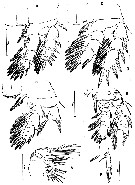|
|
 |
Fiche d'espèce de Copépode |
|
|
Misophrioida ( Ordre ) |
|
|
|
Misophriidae ( Famille ) |
|
|
|
Misophriopsis ( Genre ) |
|
|
| |
Misophriopsis sinensis Boxshall, 1986 (F) | |
| | | | | | | Syn.: | Misophria sinensis Boxshall, 1986 (p.515, figs.F); Boxshall, 1989 (p.524); Shih & Young, 1995 (p.75); Martinez Arbizu & Jaume, 1999 (p.109); Humes, 1999 (p.976) | | | | Ref.: | | | Ohtsuka & al., 1992 a (p.871, Rem.) |  issued from : G.A. Boxshall in Proc. 2nd Intern. Mar. Biol. Works.: The Marine Flora and Fauna of Hong Kong and Southern China, 1986. [p.516, Fig.1]. As Misophria sinensis. Nota: Prosome apparently 4-segmented but 1st pedigerous somite free and entirely concealed beneath a carapace-like extension from the posterior margin of the maxilliped-bearing somite. Nauplius eye absent. Rostrum small and posteroventrally directed. Surface of prosome ornamented with a reticulum of fine epicuticular lamellae. Urosome 6-segmented; somites 1 to 5 each with surface ornamentation of fine lamellae, somite 6 without such ornamentation. caudal rami wider than long; armed with 2 long distal margin setae, a medium length inner distal angle seta, a short outer distal seta, a dorsal seta near the posterolateral margin and a short lateral seta. A1 18-segmented. A2 with sympod apparently subdivided into coxa and basis; endopod 3-segmented; exopod 6-segmented. Md with well-developed gnathobase bearing along its distal margin 3 multicusped blades, 3 simple blades and 2 setiform elements; palp comprising 2-segmented endopod and 5 segmented exopod. Mx1 with praecoxal arthrite bearing 15 elements on and around the distal margin and ornamented with spinules on the anterior and ventral surfaces; coxal endite ornamented with dense cover of spinules, armed with 6 apical setae; outer lobe of coxa represented by 4 setae on lateral surface of segment; basal endite armed with 4 apical setaepalp biramous with 2-segmented endopod and 1-segmented exopod; 1st endopod segment fused to basis, armed with 5 distal angle setae; 2nd segment with 3 setae on medial margin, a subapical seta and 5 apical setae, 2 of which are truncated distally; exopod bearing 8 short plumose setae on distal margin, medial surface with patch of setules, lateral margin with row of spinules. Mxp 7-segmented, with 2-segmented protopod comprising syncoxa and basis, and 5-segmented ramus. P6 represented by plate overlying the genital opening, armed with a long seta.
|
 issued from : G.A. Boxshall in Proc. 2nd Intern. Mar. Biol. Works.: The Marine Flora and Fauna of Hong Kong and Southern China, 1986. [p.516, Fig.1]. As Misophria sinensis. Nota: Mx2 6-segmented; praecoxa with a row of setules and 6 setae on proximal endite, and a patch of setules and 3 setae on distal endite; coxa ornamented with extensive areas of spinules, bearing 3 setae on each endite; basis armed with patches of spinules laterally and medially, segment drawn out into curved medial claw bearing 4 setae proximally; ramus of 3 short segments bearing a total of 8 setae. P5 uniramous, comprising a broad protopod armed with an inner and an outer distal seta and a 2-segmented exopod.
|
 issued from : P. Martinez Arbizu & D. Jaume in Helgol. Mar. Res., 1999, 53. [p.109, Table 2]. Diagnostic features for identification. exp. 2 = exopod segment 2; exp. 3 = exopod segment 3.
| | | | | NZ: | 1 | | |
|
Carte de distribution de Misophriopsis sinensis par zones géographiques
|
| | | | | | | Loc: | | | South China Sea (Hong Kong : W Flat Island) | | | | N: | 1 | | | | Lg.: | | | (614) F: 0,333; {F: 0,33} | | | | Rem.: | Obtenu après lavage d'un Bivalve (côtier)
Voir aussi les remarques en anglais | | | Dernière mise à jour : 20/01/2015 | |
|
|
 Toute utilisation de ce site pour une publication sera mentionnée avec la référence suivante : Toute utilisation de ce site pour une publication sera mentionnée avec la référence suivante :
Razouls C., Desreumaux N., Kouwenberg J. et de Bovée F., 2005-2025. - Biodiversité des Copépodes planctoniques marins (morphologie, répartition géographique et données biologiques). Sorbonne Université, CNRS. Disponible sur http://copepodes.obs-banyuls.fr [Accédé le 23 octobre 2025] © copyright 2005-2025 Sorbonne Université, CNRS
|
|
 |
 |






